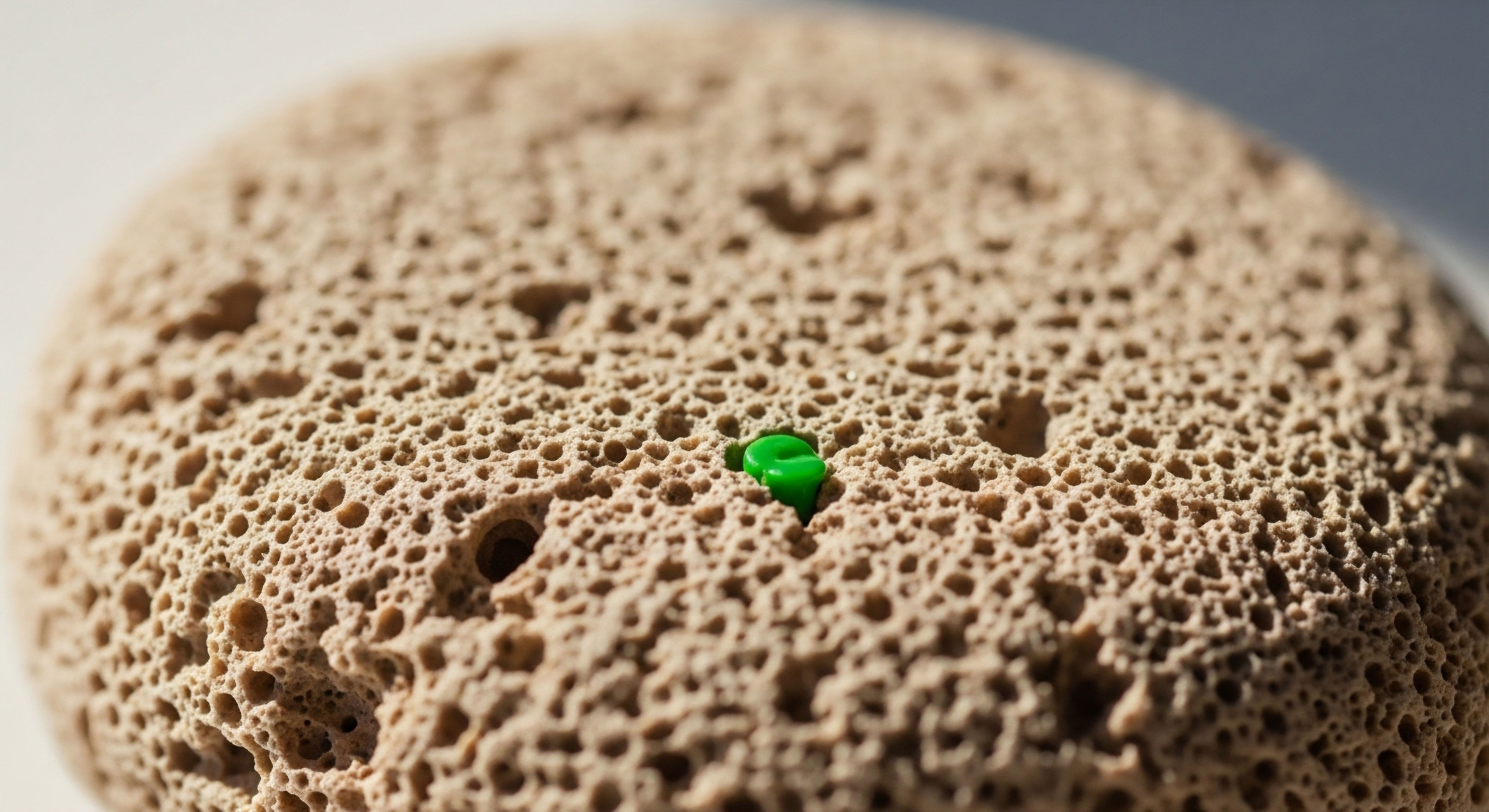

Fundamentals
Embarking on a hormonal optimization protocol is a profound step toward reclaiming your biological sovereignty. You have likely arrived here because you feel a disconnect between your internal state and the vitality you know is possible.
The fatigue, the mental fog, or the loss of drive you are experiencing is a valid and real signal from your body that a core system requires attention. When testosterone replacement therapy (TRT) is initiated, it addresses a critical deficiency. It provides the body with the essential molecule it has been missing. This is a powerful intervention, yet it represents only one part of a larger, interconnected biological conversation.
Think of your endocrine system as a finely tuned orchestra. The hypothalamus, a small region in your brain, is the conductor. It sends out a rhythmic signal, a neuropeptide called Gonadotropin-Releasing Hormone (GnRH), to the pituitary gland.
The pituitary, the orchestra’s lead violinist, responds to this beat by producing two critical musical notes ∞ Luteinizing Hormone (LH) and Follicle-Stimulating Hormone (FSH). These hormones travel through the bloodstream to the testes, which are the brass and percussion sections.
LH instructs the Leydig cells in the testes to produce testosterone, the powerful, resonant sound that influences everything from muscle mass to mood. FSH, in turn, signals the Sertoli cells to manage sperm production, ensuring the continuation of the lineage. This entire cascade is known as the Hypothalamic-Pituitary-Gonadal (HPG) axis, a constant, elegant feedback loop of communication.
The Hypothalamic-Pituitary-Gonadal axis functions as a self-regulating communication network governing testicular hormone and sperm production.
When you introduce external testosterone through TRT, you are essentially bringing a powerful amplifier to the orchestra. The overall volume of testosterone in the body rises to an optimal level, and you begin to feel the benefits. Your body, sensing this abundance of testosterone, presumes its own production is no longer needed.
The conductor, the hypothalamus, quiets its GnRH signal. The pituitary, receiving no instruction, ceases its production of LH and FSH. Consequently, the testes, with no hormonal messages arriving, fall silent. They slow their own testosterone production and reduce spermatogenesis. This is what leads to testicular atrophy, or shrinkage, a common experience for men on TRT alone. It is a logical, predictable response of a system designed for efficiency.
This is where Gonadorelin enters the protocol. Gonadorelin is a bioidentical form of the conductor’s baton, GnRH. By administering it, you are providing the precise signal that the pituitary gland needs to hear. It prompts the pituitary to continue releasing LH and FSH, even in the presence of external testosterone.
These hormones then travel to the testes, keeping the Leydig and Sertoli cells active, engaged, and functional. The purpose of using Gonadorelin during TRT is to preserve the integrity of the entire HPG axis. It ensures that your body’s innate hormonal machinery remains online and operational.
This approach validates the system’s inherent design, supporting its function rather than simply overriding it. The goal becomes a collaborative effort between the therapeutic protocol and your own biology, working in concert to restore comprehensive wellness.


Intermediate
Assessing the effectiveness of Gonadorelin within a testosterone replacement framework moves beyond subjective feelings of well-being into the objective language of clinical science. Laboratory markers are the tools we use to listen to the body’s internal conversation, verifying that the signals we are sending with Gonadorelin are being received and acted upon correctly. These markers provide a detailed portrait of the HPG axis’s vitality, ensuring the protocol is achieving its primary objective ∞ the preservation of endogenous testicular function.

Primary Markers of Pituitary Stimulation
The most direct indicators of Gonadorelin’s action are the hormones produced by the pituitary gland itself. Since Gonadorelin is a GnRH analog, its first point of contact is the anterior pituitary. A successful response is measured by the subsequent release of gonadotropins.

Luteinizing Hormone (LH)
LH is the direct signal to the testes’ Leydig cells to produce testosterone. In a male on TRT without supportive therapy, LH levels are typically suppressed to near-zero levels (<0.5 IU/L). The presence of exogenous testosterone tells the brain that no more is needed, shutting down the signal. The introduction of Gonadorelin is meant to restart this specific signal. An optimal response to Gonadorelin is demonstrated by a measurable rise in LH from its suppressed baseline. The target is not necessarily the high end of the normal range, as exogenous testosterone is still providing the bulk of the body's needs. Instead, the goal is to lift LH back into a detectable, low-normal range (e.g. 1.0 - 4.0 IU/L). This confirms the pituitary is responding to the Gonadorelin stimulus and is sending the necessary command to the testes.

Follicle-Stimulating Hormone (FSH)
FSH is the pituitary’s signal to the Sertoli cells, which are responsible for spermatogenesis. Similar to LH, FSH is suppressed during TRT. A positive Gonadorelin response includes a rise in FSH levels from their suppressed state. Maintaining some level of FSH production is directly linked to preserving fertility and testicular volume.
The target range for FSH is also within the low-normal spectrum. Observing both LH and FSH rise from their suppressed baselines is the first and most critical confirmation that Gonadorelin is effectively stimulating the pituitary gland as intended.
The primary clinical evidence of Gonadorelin’s efficacy is the restoration of detectable Luteinizing Hormone and Follicle-Stimulating Hormone levels from a suppressed state.

Downstream Markers of Testicular Response
Once the pituitary has sent its signals, we look for evidence that the testes have received and responded to them. These downstream markers confirm that the entire axis is functioning, from the brain to the gonads.
- Total and Free Testosterone ∞ While on TRT, total testosterone levels are primarily determined by the exogenous dose. However, renewed testicular activity from LH stimulation will contribute to the total pool. This can sometimes be observed as a need to slightly lower the exogenous testosterone dose to maintain the desired total T level after Gonadorelin is added. It indicates the testes are contributing their own production back into the system.
- Estradiol (E2) ∞ The testes are a primary site of aromatization, the conversion of testosterone to estradiol. When Gonadorelin successfully stimulates the testes to produce more intratesticular testosterone, it can also increase aromatization. A rise in E2 levels after initiating Gonadorelin can be an indirect marker of renewed testicular activity. This is why estrogen management, often with an aromatase inhibitor like Anastrozole, is a key component of these protocols. Monitoring E2 is essential for managing potential side effects and confirming testicular response.
- Testicular Volume ∞ A direct physical marker of Gonadorelin’s efficacy is the maintenance or restoration of testicular size. Testicular atrophy is a visible result of HPG axis shutdown. By keeping LH and FSH signals active, Gonadorelin prevents the testicular machinery from going dormant, which preserves their volume. This can be assessed by physical examination or ultrasound and is a powerful confirmation for the individual that the therapy is preserving their natural anatomy.

Functional and Comprehensive Markers
Beyond standard hormone levels, a comprehensive assessment looks at the functional output of the testes, confirming that the preserved activity translates into tangible biological processes.
| Marker | Expected Value (TRT Alone) | Target Value (TRT + Optimal Gonadorelin) | Clinical Significance |
|---|---|---|---|
| LH (IU/L) | <0.5 | 1.0 – 4.0 | Confirms pituitary response to GnRH signal. |
| FSH (IU/L) | <0.5 | 1.0 – 4.0 | Indicates stimulation of Sertoli cells for spermatogenesis. |
| Estradiol (pg/mL) | Stable (Dose-dependent) | May increase from baseline | Indirect marker of renewed testicular aromatase activity. |
| Testicular Volume | Decreased | Maintained or restored | Physical evidence of preserved testicular function. |

Semen Analysis
For individuals concerned with fertility, a semen analysis is the definitive functional marker. TRT alone consistently leads to severe oligozoospermia (very low sperm count) or azoospermia (no sperm count). The primary goal of adding Gonadorelin in this context is to maintain spermatogenesis.
A successful response is marked by the preservation of sperm count, motility, and morphology within fertile ranges. Periodic semen analysis provides the most conclusive evidence that the FSH stimulation of the Sertoli cells is achieving its ultimate biological purpose.


Academic
A sophisticated evaluation of Gonadorelin’s efficacy during hormonal optimization protocols extends into more specialized biochemical assessments. These advanced markers provide a higher-resolution view of testicular function, particularly the distinct activities of the Sertoli and Leydig cell populations.
They allow for a more granular understanding of the HPG axis’s integrity, moving beyond gonadotropin levels to measure the direct products of the testicular microenvironment. This level of analysis is critical for fine-tuning protocols and for appreciating the full spectrum of benefits derived from maintaining endogenous gonadal activity.

Inhibin B a Direct and Sensitive Marker of Sertoli Cell Function
While Follicle-Stimulating Hormone (FSH) levels indicate the presence of a signal from the pituitary, they do not directly measure the response of the target tissue. Inhibin B is a peptide hormone produced almost exclusively by the Sertoli cells of the testes in males.
Its primary role is to exert direct negative feedback on FSH secretion from the pituitary. A healthy, functional population of Sertoli cells produces Inhibin B, which travels to the pituitary and signals that FSH levels are adequate. This relationship makes serum Inhibin B a precise and sensitive biomarker of Sertoli cell health and spermatogenic activity.
In the context of TRT, where FSH is suppressed, Sertoli cell function diminishes, and consequently, Inhibin B levels fall dramatically. Upon successful stimulation with Gonadorelin, the resulting rise in endogenous FSH should reactivate the Sertoli cells. The clinical confirmation of this reactivation is a corresponding increase in serum Inhibin B levels.
Studies have demonstrated a strong positive correlation between Inhibin B concentrations and sperm count, as well as testicular volume. In many cases, Inhibin B is considered a more reliable marker of spermatogenesis than FSH itself. A low FSH level accompanied by a robust Inhibin B level suggests the Sertoli cells are healthy and responsive, requiring only a minimal FSH signal.
Conversely, a persistently low Inhibin B level despite rising FSH may indicate underlying Sertoli cell dysfunction. Therefore, monitoring Inhibin B provides a direct window into the functional status of the exocrine compartment of the testes.
Serum Inhibin B offers a direct measure of Sertoli cell activity, serving as a highly specific biomarker for the integrity of spermatogenesis.

Preservation of Endogenous Neurosteroid Precursors
The testes do more than produce testosterone and sperm. They are a crucial source of steroidogenic precursors, such as pregnenolone and DHEA, which are foundational molecules for a host of other hormones, including neurosteroids in the brain. Standard TRT, by suppressing LH and shutting down Leydig cell activity, also halts this vital production line. This is a subtle but significant consequence of HPG axis suppression.
Gonadorelin’s ability to maintain LH secretion preserves Leydig cell function in a more holistic sense. The stimulated Leydig cells continue their work of converting cholesterol into pregnenolone and its downstream metabolites. This maintains the body’s supply of these essential precursors.
These molecules can then travel to other tissues, including the brain, where they are converted into vital neurosteroids like allopregnanolone. Neurosteroids are potent modulators of neurotransmitter systems, particularly GABA-A receptors, and play a critical role in mood, cognitive function, and neuronal health.
The preservation of this pathway may help explain the subjective reports of improved cognitive clarity and emotional resilience in individuals on TRT with HPG axis support, compared to those on TRT alone. Measuring serum pregnenolone can serve as a proxy marker for this preserved upstream steroidogenic activity, offering another layer of validation for the Gonadorelin protocol’s comprehensive benefits.

What Are the Implications for Dosing and Pulsatility?
The native secretion of GnRH from the hypothalamus is pulsatile, occurring roughly every 90-120 minutes. This rhythmic release is essential for maintaining the sensitivity of the pituitary’s GnRH receptors. Continuous, non-pulsatile exposure to GnRH or its agonists can, paradoxically, lead to receptor downregulation and a shutdown of gonadotropin secretion. This is the mechanism by which long-acting GnRH agonists are used for chemical castration in certain medical contexts.
Gonadorelin has a very short half-life of 2 to 20 minutes. This makes mimicking the body’s natural pulsatility a clinical challenge with standard injection schedules. Clinical studies demonstrating robust efficacy often utilize subcutaneous infusion pumps that deliver microdoses every 90-120 minutes, closely replicating the natural rhythm. For most individuals on TRT, such a regimen is impractical.
The standard protocol of daily or twice-daily subcutaneous injections represents a clinical compromise. It aims to provide enough of a stimulus to prevent complete testicular shutdown without causing desensitization. The clinical markers discussed ∞ LH, FSH, and Inhibin B ∞ are therefore essential for titrating the dose and frequency of these injections to find the optimal balance for each individual, ensuring the signal is strong enough to be effective yet intermittent enough to be sustainable.
| Advanced Marker | Biological Origin | Clinical Indication | Significance in TRT + Gonadorelin Protocol |
|---|---|---|---|
| Inhibin B | Sertoli Cells (Testes) | Direct marker of spermatogenesis and Sertoli cell function. | A rise in Inhibin B confirms functional response to FSH stimulation, often more reliably than FSH alone. |
| Pregnenolone | Leydig Cells (Testes) / Adrenal Glands | Marker of upstream steroidogenesis. | Maintenance of levels indicates preserved Leydig cell function beyond just testosterone production, supporting neurosteroid pathways. |
| Semen Analysis Parameters | Seminiferous Tubules | Definitive measure of fertility. | Preservation of sperm count, motility, and morphology is the ultimate functional validation of the protocol’s success. |

References
- “Benefits of Gonadorelin in Testosterone Replacement Therapy.” Prometheuz HRT, 2024.
- “Gonadorelin for TRT and its clinical use for patients on testosterone replacement therapy.” NovaGenix, 2020.
- “A study of the effects of gonadotropin-releasing hormone on human mood and behavior.” Psychoneuroendocrinology, 1979.
- Anawalt, B. D. et al. “Serum inhibin B levels reflect Sertoli cell function in normal men and men with testicular dysfunction.” The Journal of Clinical Endocrinology & Metabolism, vol. 81, no. 9, 1996, pp. 3341-5.
- “Management of Male Fertility in Hypogonadal Patients on Testosterone Replacement Therapy.” Medicina, 2024.
- Nieschlag, E. et al. “High Loading and Low Maintenance Doses of a Gonadotropin-Releasing Hormone Antagonist Effectively Suppress Serum Luteinizing Hormone, Follicle-Stimulating Hormone, and Testosterone in Normal Men.” The Journal of Clinical Endocrinology & Metabolism, vol. 83, no. 10, 1998, pp. 3499-505.
- “Gonadotropin-releasing hormone.” Wikipedia, Wikimedia Foundation, 2024.
- Weinbauer, G. F. et al. “Regulation of primate testicular function by GnRH analogues.” Scandinavian journal of urology and nephrology. Supplementum, vol. 137, 1991, pp. 81-9.
- Pierik, F. H. et al. “Serum Inhibin B as a Marker of Spermatogenesis.” The Journal of Clinical Endocrinology & Metabolism, vol. 83, no. 9, 1998, pp. 3110-4.
- “Neurosteroid Metabolites of Gonadal Steroid Hormones in Neuroprotection ∞ Implications for Sex Differences in Neurodegenerative Disease.” Frontiers in Neuroendocrinology, 2017.

Reflection
The information presented here offers a map of the biological territory you are navigating. These clinical markers, from the foundational gonadotropins to the nuanced signals of Inhibin B, are the landmarks and signposts on that map. They provide an objective language to describe the internal shifts that accompany a well-managed therapeutic protocol.
Your personal journey, however, is the lived experience of traveling through that territory. The data points on a lab report find their true meaning when they correlate with a renewed sense of energy, a clearing of mental fog, and a return of your fundamental drive.
This process is a partnership between you, your clinician, and your own intricate physiology. The ultimate goal is to use this knowledge not just to read the map, but to confidently walk the path toward sustainable vitality and function.



